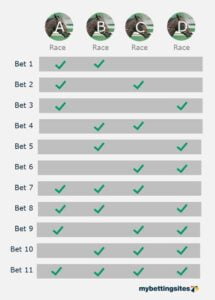
Simple Horse Racing Systems: A Beginner’s Guide
Horse racing is a thrilling sport that has captivated audiences for centuries.
Whether you’re a seasoned bettor or a newcomer to the world of horse racing betting, understanding the various systems can greatly improve your chances of success. In this beginner’s guide, we will delve into the basics of horse racing systems and explore some simple yet effective strategies that can help you identify winning horses and maximize your returns.
Understanding the Basics of Horse Racing
Before diving into the world of horse racing systems, it’s important to have a solid understanding of the basics. Horse racing involves a number of factors such as the horse’s form, jockey performance, track conditions, and race distance. By analyzing these variables, you can make more informed decisions when it comes to selecting winning horses.
Racing Experts is here to help you make sure your knowledge is up to scratch on this point.
When it comes to the horse’s form, it refers to its recent performances in previous races. This includes factors such as finishing position, speed, and consistency. By studying a horse’s form, you can gain insights into its current fitness and ability to perform well in upcoming races.
Jockey performance is another crucial factor to consider. A skilled jockey can make a significant difference in a horse’s performance. Their ability to navigate the track, make strategic decisions during the race, and communicate effectively with the horse can greatly impact the outcome.
Track conditions play a vital role in horse racing. Different horses perform better on different track surfaces, such as dirt, turf, or synthetic. Additionally, weather conditions can affect the track, making it either fast or slow. It’s essential to consider how a horse has performed on similar track conditions in the past to gauge its chances of success.
Race distance is another important factor to consider. Some horses excel in shorter sprints, while others have the stamina to perform well in longer races. Understanding a horse’s preferred distance can help you identify races where it has a higher chance of success.
It’s also crucial to familiarize yourself with the different types of races, such as flat racing, steeplechase, and harness racing. Each type of race requires a different set of skills and strategies, so it’s essential to adapt your approach accordingly.
Flat racing is the most common type of horse racing, where horses compete on a flat track without any obstacles. It tests a horse’s speed and endurance, with races ranging from short sprints to longer distances.
Steeplechase, on the other hand, involves horses racing over obstacles such as fences and ditches. This type of racing requires not only speed and endurance but also jumping ability and agility.
Additionally, learning how to read a racing form can provide valuable insights into a horse’s past performances, enabling you to identify patterns and trends that may influence its future performance. The racing form typically includes information such as the horse’s recent finishes, jockey and trainer statistics, and details about the track and race conditions. By analyzing this data, you can gain a deeper understanding of a horse’s capabilities and make more informed betting decisions.
By understanding the basics of horse racing, you are laying the foundation for developing effective betting systems. Armed with knowledge about the horse’s form, jockey performance, track conditions, race distance, and different types of races, you can approach horse racing with a strategic mindset and increase your chances of success.
Identifying Winning Horses with Ease
One of the key goals of a horse racing system is to help bettors identify winning horses with ease. While there is no foolproof method for predicting the outcome of a race, there are several simple strategies that can increase your chances of success.
A popular approach is to focus on horses with consistent past performances. This involves analyzing a horse’s recent races and looking for patterns of success. If a horse has consistently finished in the top three positions in its previous races, it may be a strong contender for future races.
For example, let’s consider a horse named “Thunderbolt”. In the past five races, Thunderbolt has finished first twice and second three times. This consistent performance indicates that Thunderbolt has the potential to be a winning horse in future races as well.
Another effective strategy is to evaluate the horse’s form, paying close attention to recent races and its performance in similar conditions. If a horse has performed well in races with similar track conditions, distance, and class level, it may have a higher chance of success in the current race.
Let’s take the example of a horse named “Silver Bullet”. Silver Bullet has recently participated in a race with a similar track condition and distance as the upcoming race. In that race, Silver Bullet finished first, showcasing its ability to perform well under similar circumstances. This indicates that Silver Bullet might have an advantage in the upcoming race as well.
Furthermore, considering the jockey’s track record can provide valuable insights into a horse’s potential. Experienced jockeys who have a history of winning races may increase the chances of their horse performing well.
For instance, let’s consider a jockey named John Smith. John Smith has a remarkable track record, having won multiple races in the past. If John Smith is the jockey for a horse named “Midnight Star”, it adds credibility to Midnight Star’s chances of winning the race.
Additionally, it is essential to analyze the horse’s training regimen and overall health. Horses that have undergone consistent training and are in good physical condition are more likely to perform well in races. Regular exercise, a balanced diet, and proper rest are crucial factors that contribute to a horse’s overall fitness.
Moreover, studying the horse’s pedigree can provide valuable insights into its potential performance. A horse with a strong lineage of successful racehorses may inherit the traits and abilities necessary for winning races.
Lastly, keeping an eye on the betting odds can also be helpful in identifying winning horses. If a horse has favorable odds, it indicates that the betting public believes in its chances of winning. However, it is important to note that odds alone should not be the sole determining factor, as they can be influenced by various factors such as public sentiment and market manipulation.
Top 5 Simple Racing Systems for Beginners
Here’s a summary of example horse racing systems that punters might use, create or tweak to suit their own betting style.
The 3-Point System:
This system involves assigning points to different factors such as recent form, jockey performance, and track conditions. By totaling the points for each horse, you can assess their overall chances of winning.
The Speed Rating System:
In this system, you focus on a horse’s speed ratings, which are a measure of its previous race times. By comparing speed ratings across different horses, you can identify those with the highest likelihood of winning.
The Class System:
This system involves evaluating the class of a race and the class of the horses competing in it. Horses that have consistently competed and performed well in higher classes may have an advantage over their competitors.
The Money Management System:
While not directly related to horse selection, proper money management is crucial for long-term success. This system helps you create a budget and allocate your bets in a way that maximizes your returns and minimizes losses.
The Lay System:
This system involves identifying horses that are unlikely to win and laying bets against them. By focusing on horses with poor recent performances or unfavorable conditions, you can increase your chances of success.
Maximizing Your Returns: Tips and Tricks
Once you have selected your horses using a system that suits your betting style, there are several tips and tricks that can help you maximize your returns. Professional gamblers and horse racing tipsters are experts at this.
Firstly, it’s important to set realistic expectations and not be too greedy. While it’s tempting to aim for big wins, focusing on consistent, smaller profits can be more sustainable in the long run.
Additionally, keeping track of your bets and analyzing your results can provide valuable insights into your betting performance. By identifying patterns of success and areas for improvement, you can refine your strategies and enhance your chances of success.
Lastly, it’s crucial to stay disciplined and avoid chasing losses. Losing streaks are inevitable in horse racing, and it’s important to recognize when it’s time to take a break or reassess your strategy. Emotional betting can lead to poor decision-making and significant losses.
Case Studies: Simple Betting Systems in Action
To illustrate the effectiveness of simple horse racing systems, let’s explore some case studies where these uncomplicated betting strategies have been successfully applied.
In one case, a punter used the 3-Point System to select horses with consistent form, favorable track conditions, and experienced jockeys. Over a period of six months, they achieved a 30% return on investment, proving the effectiveness of a well-structured system.
In another case, a bettor focused on the Speed Rating System and identified horses with consistently high ratings. They managed to achieve a 50% strike rate, resulting in a significant boost to their betting bankroll.
These case studies highlight the value of implementing simple yet effective horse racing betting systems and demonstrate that with the right approach, even beginners can achieve success in the world of horse racing betting.
In conclusion, horse racing systems provide a structured approach for identifying winning horses and maximizing your returns. By understanding the basics of horse racing, utilizing simple strategies, and staying disciplined, you can increase your chances of success in this exhilarating sport. Whether you choose to implement the 3-Point System, the Speed Rating System, or any other system that suits your style, remember to approach betting with a calculated mindset and enjoy the thrill of the race.















